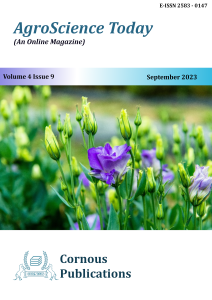Alley cropping is the production of arable crops between rows of trees or shrubs. In this system trees are often pruned to reduce shading effect on the agricultural crops. Alley cropping system is generally recommended for humid tropics condition. Moreover, in semiarid regions of India alley cropping provides feed to the livestock especially during the off season. The primary objective of this cropping system is to provide green fodder for livestock, effective utilization of off season rainfall and to reduce soil and water erosion.
According to the climatic and geographical requirements of each of the wheat growing zones, ICAR-Indian Institute of Wheat and Barley Research, Karnal and other agricultural universities produce different varieties to provide good quality seeds to the farmers. Farmers can produce good quality seed at their own field by selecting improved varieties and following standard package of practices as per sowing conditions.
A weed is a plant considered undesirable in a particular situation, growing where it conflicts with human preferences, needs, or goals. Weed management is one of the most crucial aspects of agriculture and land maintenance, aiming to control and minimize the impact of unwanted plants or “weeds”. The main objective is to mitigate weed competition with desirable crops, ensuring optimal growth and yield. Farmers and land managers employ various methods, such as cultural practices, mechanical cultivation, use of herbicides, mulching, and biological control, to suppress weeds effectively. Integrated weed management combines multiple practices to reduce the reliance on any single method, promoting sustainability and minimizing environmental harm. Effective weed management not only enhances crop productivity but also conserves soil health, water resources, and biodiversity, making it an essential practice in modern agriculture and land stewardship. Weed management involves various methods and strategies to control and reduce weed populations.
Centella asiatica is a traditional medicinal herb which is called as Indian pennywort and Asiatic Pennywort in English, Mandukaparni in Sanskrit and Vallarai in Tamil. As the pharmaceutical and cosmetic importance of Centella asiatica is being explored, the other species being mixed by its name is also surging out. The article discusses on the plant species being used or misidentified in the name of Indian Pennywort.
In the Indian Agricultural economy, oilseeds are the second largest sector next to cereals. India places the top rank in the production in the world. Sesame (Sesamum indicum L.) is the oldest oilseed crop in India with holds the longest history of cultivation. Sesame oil is traditionally valued oil due to the high amount of polyunsaturated fatty acids, oleic acid, and linoleic acid present in oil. The productivity of sesame in India is 431 kg/ha. This was due to the non-adoption of improved cultivation practices. The primary reasons for lower productivity in sesame are mainly cultivated under the rainfed situation with poor crop management practices. Lack of availability of location-specific varieties, varieties resistant to pests and diseases also the reason for low yield. The weather abnormalities lead to increases in the incidence of pests and diseases which leads to yield reduction. In this aspect to manage all the issues in sesame cultivation we must implement good agricultural practices to achieve a higher yield and economics.
Eustoma, also known as lisianthus, is a graceful, versatile flower with delicate petals, soft color palette, and symbolism. Originating in the US and Mexico, it gained popularity in the 1930s. Its rose-like appearance, long vase life, and symbolism make it ideal for expressing admiration or heartfelt sentiments. Eustoma is used in various cultures, including Japan, Western culture, and China, where it symbolizes appreciation and gratitude.
